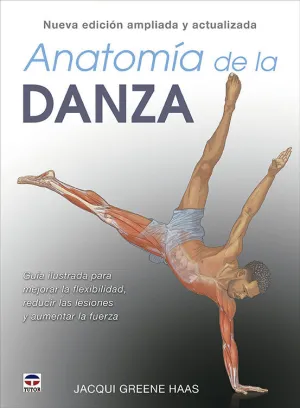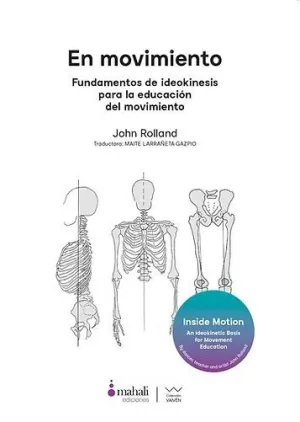
- Editorial:
- HUMAN KINETICS
- Año de edición:
- 2014
- Materia:
- DANZA, BALLET, BAILE
- ISBN:
- 978-1-4504-2190-4
- Páginas:
- 228
EXPERIENCING DANCE FROM STUDENT TO DANCE ARTIST
HELENE SCHEFF, MARTY SPRAGUE, SUSAN MCGREEVY-NICHOLS
Experiencing Dance: From Student to Dance Artist, Second Edition, presents a complete dance education curriculum for high school students who have more than an introductory experience in dance. The text, with more than 45 lessons, will help students create, perform, respond to, analyze, connect, and understand dance in various styles and settings.
The lessons focus on all aspects of dance, including understanding movement potential, dance science, dance forms, historical and cultural aspects of dance, and future career directions. The first edition of Experiencing Dance was a best-selling text for high school dance coursesand this edition, with its updated lesson plans, full-color design, and student and teacher web resources, promises to be just as popular, if not more so.
Experiencing Dance: From Student to Dance Artist, Second Edition, will help students in these ways:
Experience dance through creating, performing, responding to, analyzing, connecting with, and understanding dance
Understand dance in historical and cultural contexts, its role in community settings, and its potential in career options
Learn from a flexible curriculum that can cover one or more years of instruction and that is designed for dancers with more than an introductory experience
Engage in a course that meets state and national standards in dance education and addresses 21st-century learning goals
Develop a dance portfolio and connect class learning with the real world of dance
Experiencing Dance provides everything teachers need in order to teach dance to students. This curriculum includes these features:
15 chapters with more than 45lessons that help students create, perform, respond to, connect with, analyze, and understand dance
Lessons that focus on all aspects of dance, including understanding movement potential, dance science, dance forms, historical and cultural aspects of dance, and future career directions
Material that is targeted to students who are coming in with previous dance experience
Content that meets state and national standards in dance education and connects to 21st-century skills for the workforce
Web resources that will help students make the connection between classroom learning and real-world dancing
An iBooks interactive version with assignments, video clips, and interactive quizzes
Contents
Credits
How to Use the Book and Web Resources
Unit I. Recognizing Your Movement Potential
Chapter 1. Surveying Your Body at Work
Lesson 1.1 Stand on Your Own Two Feet
Lesson 1.2 Body Mechanics: Matching Movement to Muscles and Bones
Lesson 1.3 Dancing at the Joint
Lesson 1.4 Personal Physical Survey
Chapter 2. Warming Up and Cooling Down
Lesson 2.1 Your Personal Warm-Up
Lesson 2.2 Dance Class Basics
Lesson 2.3 Stretch What You Strengthen and Cool Down
Chapter 3. Choosing a Dance Form That Suits You
Lesson 3.1 Determine Your Movement Preferences
Lesson 3.2 Recognize Your Physical Traits and Abilities
Lesson 3.3 Connect Your Physical Traits and Abilities With Movement Preferences
Chapter 4. Learning More Than Steps
Lesson 4.1 Develop Thinking Skills Through the Study of Dance
Lesson 4.2 Apply Dance Learning Strategies to Other Life Situations
Lesson 4.3 Explore Careers Beyond Performing
Unit II. Becoming a Dancer
Chapter 5. Diversifying Your Dance Training
Lesson 5.1 Apply Basic Techniques to All Dance Forms
Lesson 5.2 Experience Different Styles of Dance
Lesson 5.3 Hone Your Rehearsal and Performing Strategies
Chapter 6. Improving Your Skills
Lesson 6.1 Find Classes and Teachers That Meet Your Needs
Lesson 6.2 Share Your Knowledge
Lesson 6.3 Practice Makes Permanent
Unit III. Making Connections Through Dance
Chapter 7. Expressing Ideas and Emotions
Lesson 7.1 Dance as Nonverbal Communication
Lesson 7.2 Dance as a Report or Essay Without Words
Lesson 7.3 Dance as Social Commentary
Chapter 8. Exploring Dance as an Art Form
Lesson 8.1 Differences Between Everyday Movement and Dance
Lesson 8.2 Theatrical Dance
Lesson 8.3 Your Aesthetic Preferences
Chapter 9. Connecting to Community and Tradition
Lesson 9.1 Cultural Dance
Lesson 9.2 Historical Dance
Lesson 9.3 Social Dance
Unit IV. Becoming a Choreographer
Chapter 10. Creating Dances
Lesson 10.1 Choreographic Elements
Lesson 10.2 Choreographic Processes
Lesson 10.3 Choreographic Structures
Chapter 11. A Seven-Step Method for Choreography
Lesson 11.1 Choose Subject Matter and Explore Movement
Lesson 11.2 Coordinate Music and Movement, Explore Possibilities, Refine, and Memorize
Lesson 11.3 Add Finishing Touches and Perform
Chapter 12. Showcasing Your Work
Lesson 12.1 Costumes and Props
Lesson 12.2 Lighting, Scenery, and Sound
Lesson 12.3 Production Information and Time Line
Unit V. Refining Yourself as a Dance Artist
Chapter 13. Learning From the Works of Others
Lesson 13.1 View, Analyze, and Critique Others Works
Lesson 13.2 Learn From the Choreography of Others
Lesson 13.3 Improve Your Performance by Watching Others
Chapter 14. Sharing Your Art Form
Lesson 14.1 Create and Plan Presentations for Specific Settings
Lesson 14.2 Find Places to Share Your Presentation
Lesson 14.3 Give Back to Your Community
Chapter 15. Developing Your Portfolio, Résumé and Audition Skills
Lesson 15.1 Build Your Portfolio
Lesson 15.2 Create Your Résumé
Lesson 15.3 Prepare for Auditions
Glossary
References and Resources
Index
Audiences
Text for high school Dance II, III & IV courses.






